Archived Commercial Blog Posts
Central Park West Commercial Water Damage Restoration Project: A Comprehensive Overview
8/3/2023 (Permalink)
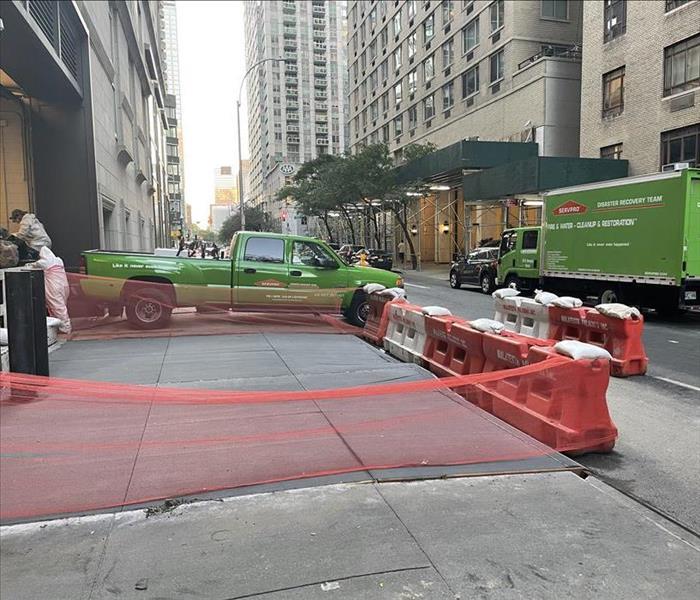 Our Disaster Recovery Team can respond to commercial water damage projects nationwide!
Our Disaster Recovery Team can respond to commercial water damage projects nationwide!
The Central Park West Commercial Water Damage Restoration Project stands as a testament to the expertise and efficiency of SERVPRO Team Bisig. Faced with a catastrophic scenario after Hurricane Ida's fury, the team managed to turn the tide in a situation that could have been detrimental for this high-end apartment complex. Here's a detailed look at the challenges, actions, and outcomes of this massive restoration project.
The Challenge: A Disaster Unleashed by Hurricane Ida
Hurricane Ida will be remembered for its destructive force, and the Central Park West apartment complex faced the brunt of it. The subway system below the building became flooded, resulting in a rupture of the concrete slab that formed the basement's foundation. The entire basement area, spanning an incredible 60,000 sq ft, was filled with water. The potential damage was not only to the structure but also to the electrical systems and other vital components housed in the basement.
Immediate Response: Mobilizing SERVPRO Team Bisig
Time was of the essence, and SERVPRO Team Bisig was mobilized quickly to assess and contain the situation. The team's first priority was to stabilize the building to prevent any further structural damage. This involved pumping out the floodwaters and taking measures to ensure that the integrity of the foundation was maintained.
Water Damage Restoration: A Multifaceted Approach
The water damage restoration process was complex and multifaceted. It involved:
- Water Extraction: Industrial pumps and vacuum units were used to remove thousands of gallons of water.
- Structural Drying: Specialized equipment was utilized to dry the structure completely, including the use of dehumidifiers and air movers.
- Decontamination: The floodwater had brought contamination into the building. Thorough cleaning and sanitization were essential to prevent health hazards.
- Concrete Slab Repair: The rupture of the concrete slab required skilled engineering to repair and reinforce.
- Electrical and Mechanical Systems Restoration: The water had affected the basement's electrical and mechanical systems. These were carefully restored to full functionality.
- Interior Restoration: Some of the interior finishes and components needed repair or replacement, including walls, floors, and fittings.
Financial Overview: A Project Worth $2.5 Million
The total cost of this restoration project reached $2.5 million. This figure reflects not only the magnitude of the damage but also the comprehensive approach taken to restore the building to its preloss condition. Insurance and financial arrangements were handled with professionalism and efficiency.
The Outcome: Success Against the Odds
The Central Park West Commercial Water Damage Restoration Project was completed successfully, with the building restored to its former glory. Residents were able to return to their homes, and the potential long-term damage was averted.
Conclusion: SERVPRO Team Bisig - A Name to Trust
The restoration of the Central Park West apartment complex underscores SERVPRO Team Bisig's expertise in commercial water damage restoration. Their ability to respond swiftly, mobilize resources, and execute a restoration plan with precision makes them a trusted name in the industry.
For those in need of water damage restoration services, whether due to a natural disaster or other causes, SERVPRO Team Bisig is ready to assist. Their commitment to excellence ensures that even the most challenging situations can be handled with professionalism and care.
Commercial Systems Prone to Water Damage: SERVPRO of Buford/Suwanee/Hamilton Mill
4/28/2022 (Permalink)
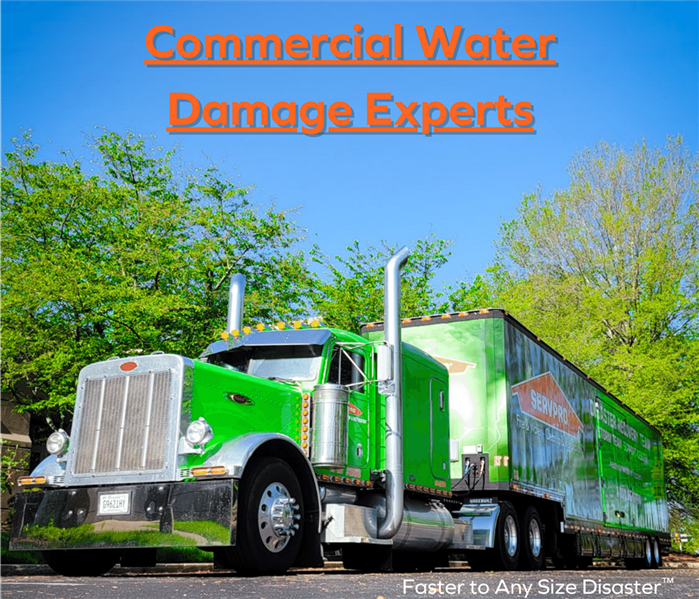 SERVPRO of Buford/Suwanee/Hamilton Mill is ready for whatever happens! We'll restore your business after any size of property damage.
SERVPRO of Buford/Suwanee/Hamilton Mill is ready for whatever happens! We'll restore your business after any size of property damage.
Commercial properties present unique risks when it comes to water damage in Dacula, GA. Unlike residential homes, which are usually one story and have easily accessible crawl spaces and attics, commercial buildings can be many stories high with flat roofs and multiple storefront windows. They also often have expensive specialized equipment that can be very costly to repair or replace if damaged by water. In this blog post, we will discuss the different parts of a commercial building that are at risk for water damage, as well as some tips on how to prevent it.
Plumbing Systems
The first and most obvious risk for water damage in a commercial property is the plumbing system. Because commercial buildings have more bathrooms, kitchens, and other water-using fixtures, they also have larger and more complex plumbing systems. These systems are often located in hard-to-reach places, making them difficult to repair if they spring a leak.
One of the main water damage challenges according to The Hartford Insurance is an improperly maintained sprinkler system. By law, most commercial buildings must have a fire sprinkler system, but many building owners forget to regularly maintain and test these systems. While a well-maintained fire sprinkler system can help prevent extensive fire damage in the event of a fire, improper maintenance or disaster planning can cause extensive water damage that can flood multiple floors.
Another plumbing risk is burst pipes. Commercial buildings, especially high rises tend to run at a higher pressure than residential buildings. Therefore, a burst pipe has the potential to release significantly more water than a home.
One of the ways in which we help commercial property owners prevent catastrophic property damage before it happens is through our app-based Emergency Response Planning program (ERP).
Roofing Systems
In addition to the plumbing system, there are a number of exterior commercial building components that can experience water damage. One of the most common is the flat roof. Because flat roofs are not sloped like traditional pitched roofs, they tend to pool water instead of shedding it. This can lead to leaks and eventually, if left unaddressed, major water damage.
Some common commercial roofing systems include:
- Built-up Roofing (BUR): Often called tar and gravel roofs, these commercial roofing systems are built with a semi-continuous membrane installed in layers, then covered in aggregate. While they are usually simple to maintain, best practices suggest inspecting the roof for deterioration and possible leak points at least twice yearly.
- Thermoplastic Single-Ply Membrane Roofing (PVC & TPO): These roofs are installed in large rolls that are then welded together at the seams with heat. The material is very durable and oil-resistant. However, the heat-welding methods require skilled installation, which can lead to weak points and leak-prone areas if not performed correctly.
- EPDM Roofing: Some roofers call these "rubber roofs" because the material they are made of, ethylene propylene diene monomer is very rubber-like. This kind of roof is derived from oil and natural gas, and appears dark gray or black. When installed correctly and with the highest thickness available, this type of commercial roof will last a very long time with little to no issues. Unless you experience storm damage in your area, an annual check for leaks around the roof penetrations should suffice.
Window Systems
Commercial window systems are built for durability and use, however, they can often present a unique water damage challenge for commercial facilities. Most aluminum glazing systems aren't intended to be 100% waterproof. Most commercial window systems are meant to limit water penetration during extreme circumstances while also weeping water back out to the exterior.
By directing all moisture to the sill flashing, storefront systems limit water penetration. It's critical that the sill flashing be installed correctly in order to avoid water damage. Making sure that sealant is put on the top of the rear leg before installing the sill is one of the most important aspects of a good installation.
The most essential aspect of maintaining water penetration with a storefront is end dam fastening and sealing. Water will enter the building through the jamb locations if end dams are not properly fastened and sealed. Improperly (or missing) end dams can cause significant water damage to the interior drywall or flooring around commercial storefront windows.
Like anything else in a building, time and the elements can cause wear and tear and failure of these commercial window water control systems.
Commercial Water Damage Inspection Services
So if you notice moisture or water damage around your storefront windows, you should consider calling SERVPRO of Buford/Suwanee/Hamilton Mill to inspect for potential water damage issues. Our technicians are trained to identify, troubleshoot, and restore all types of commercial water issues.
Call today to schedule your commercial service!
(770) 945-5355
5 Flood Preparation Tips for Your Business
2/2/2022 (Permalink)
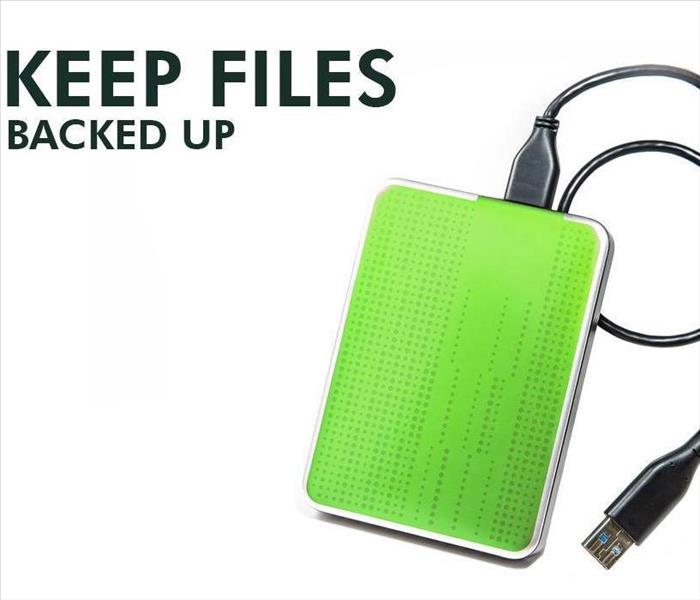 Back up any files.
Back up any files.
Flood Preparation Tips
When it comes to flooding in Sugar Hill, GA, one of the first things you may want to do is protect your business. Fortunately, there are many useful flood preparation tips you can use if you believe your company property may be in danger. Here are a few you may want to consider.
1. Know Your Flood Risk
Knowing your flood risk can help you protect your business from flood damage. Your risk factors include things such as the location of your building, and the type of weather in your area.
2. Keep an Eye on the Weather
It's also important to know what type of weather to expect in your area. If you experience frequent rain or snow you may want to take more permanent measures such as the inclusion of a retaining wall around the property.
3. Back Up Any Files
One unfortunate side effect of flooding is that oftentimes electronics and files can be damaged. You can take precautions by backing up electronic files on a server, and putting paper files away from areas that could be flooded.
4. Protect the Building
If you know a storm is coming you may want to protect your business building from flood damage. Some precautions you can take include boarding over windows, sloping your landscaping away from the building, and moving any furniture or electronics away from doors and windows.
5. Make Repairs Quickly
If your company building is flooded, then you may want to contact a flood damage restoration service as it's important to get in repairs completed as quickly as possible. Not only are quick repairs important for reducing a possibility of additional damage, but they can also help ensure your business stays up and running.
When it comes to flooding, being prepared ahead of time can help you protect your business property. A few helpful tips include knowing your flood rest, keeping an eye on the weather for potential storms, backing up any of your files that could potentially be damaged, and doing what you need to do to protect the property.
Immediate Response Can Reduce Water Damage Exposure
12/28/2021 (Permalink)
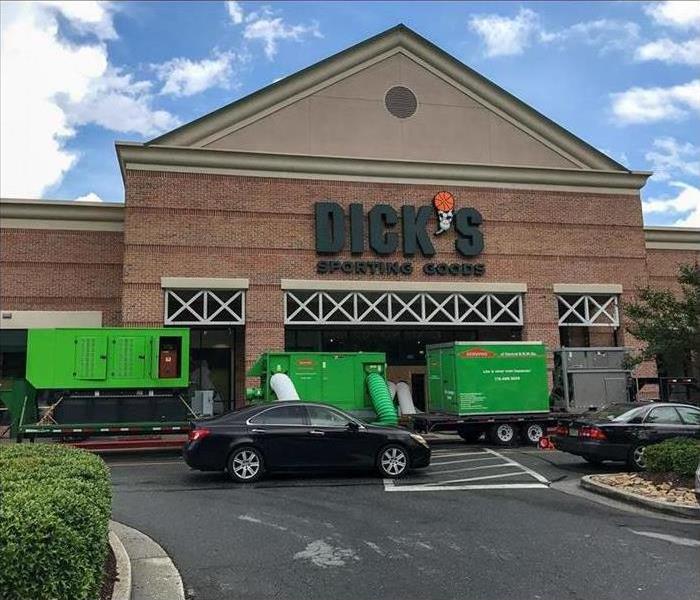 Commercial water damage in Naples Lakes, FL.
Commercial water damage in Naples Lakes, FL.
Cleaning Up After Flood Damage
When you have water damage to your building in Naples Lakes, FL, you need to act fast, but you need your actions to count. Here are important steps to take when you are cleaning up from a flood.
1. Call an expert. Commercial water damage restoration specialists have the expertise and knowledge to get you through the cleanup and recovery process. Since time is so critical, call them before you do anything else.
2. Make sure it’s safe. While you are waiting for help to arrive, you can begin cleanup. Before you do, make sure it is safe. Turn off electricity before entering a flood water area, and don’t use lights or appliances that have been in contact with water. If flooding is caused by black water, protect your body from direct contact.
3. Start removing water. Grab mops, sponges and rags to start the water cleanup process while you wait for the professionals to arrive.
4. Protect key documents. Make sure your most important documents are removed from ground level to reduce exposure to water.
5. Protect furniture. Wooden furniture is porous and absorbent and needs to be set up on blocks or foil so that it doesn’t remain in contact with a soggy floor.
6. Remove carpet and rugs. Experts will help you decide if rugs and carpets can be saved, but removing them will increase your chances. If you can put them outside to dry, go ahead and start that.
7. Gather personal belongings. Picking up personal items from the floor will help make sure the room is ready for the experts to use their commercial pumps and water removers to minimize water damage.
Restoration experts will do all these, but you can increase your chances of saving items by taking action while you wait.
Fast Action Makes a Difference
Broken pipes can wreak havoc in your building, but you can help reduce your losses by having a plan in place to contact professional help and to start cleanup immediately.
Fire Risks to a Commercial Office and Tips to Reduce Them
12/23/2021 (Permalink)
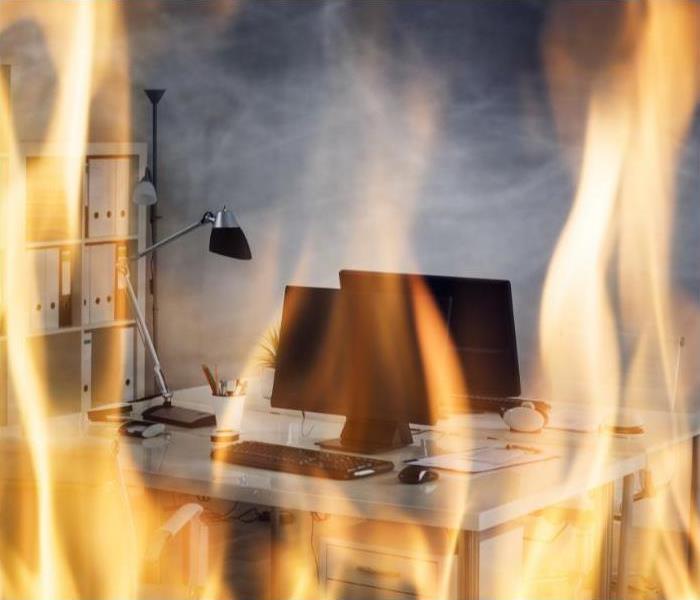 Office Fire
Office Fire
Our homes and our businesses in Hog Mountain or Peachtree Ridge are our castles, which is why we work hard to make them as safe and secure as possible. Unfortunately, there are some hazards that may not be obvious and can cause damage to your office, in the form of fire or water damage. Even more unfortunate? The cost of these damages, which could run into the thousands of dollars, and can come out of your pocket—whether you’re an individual homeowner or a business owner or landlord. Here are some common causes of fire and water damage in commercial office buildings, as well as tips on how to prevent them from occurring and damaging your home or commercial property.
Understanding Building Fire Damage
Most office building fires are small. But even a small fire can do a lot of damage if it gets out of control or isn’t contained early on. One of the biggest dangers is smoke and fire damage to your home or commercial office's interiors. Smoke can permeate materials, carpets, walls, flooring, ceilings—even drywall joints—leaving hidden danger behind long after flames have been extinguished. Even if you can’t see any visible signs of fire or smoke damage, you should always have an experienced professional examine your property for lingering toxins from before you move back in.
According to this report by the NFPA, there are 7 main causes of fires in commercial office buildings. Cooking Equipment, Electrical distribution and lighting equipment, heating equipment, intentional damage, smoking materials, exposure to other fire sources, and electronic, office, or entertainment equipment. This statistic includes general business offices, banks, veterinary or research offices, engineering, mailing firms, and post offices.
Common Causes of Commercial Building Fires
Most office fires are caused by cooking equipment, accounting for slightly over one in every four commercial office fires. However, while these fires are the most common, they do not account for most of the property damage to office buildings. That position is taken by the intentional damage category. Intentional damage alone accounts for a full 20% of commercial fire property damage. Intentional Property Damage occurs when a person seeks to purposely damage the office property through arson.
Two other leading causes of fire in office buildings are heating equipment, electrical distribution, and lighting equipment. Together, they account for 18% of property damage to commercial office buildings. These can include things such as space heaters, light fixtures, electrical wiring, outlets, electrical appliances, extension cords, and more.
While lower on the list, smoking materials, electronic, office, or entertainment equipment account for 12% of commercial office property damage.
Lastly, exposure fires, as defined by the National Fire Incident Reporting System (NFIRS), are fires resulting from another fire outside of the commercial building itself. This kind of commercial fire damage accounted for 18% of property loss.
What Can I Do To Prevent A Building Fire?
If your building was constructed with modern building materials, fire damage should be a rare occurrence. But it can still happen if you’re not careful. Make sure all smoking materials are safely extinguished before leaving work each day. A smoldering cigarette can ignite more easily than you think. Also, make sure to regularly inspect your smoke alarms, carbon monoxide detectors, and fire suppression systems to ensure they’re working properly. If a smoke alarm goes off for no reason at all, make sure to replace or recharge its batteries immediately.
The NFPA uncovered another intriguing statistic about fires on weekends and between the nighttime hours of 7pm and 7am. 19% of fires occurred on weekends but accounted for 31% of fire-related property losses. Meanwhile, fires at night accounted for less than one-third of office property fires, yet caused 67% of direct property damage due to fires.
Automatic Fire Detection & Fire Extinguishing Systems: This shows that one of the most important steps you can take towards protecting your office building from fire damage is to install and maintain automatic detection and fire extinguishing systems.
Camera monitoring systems such as those installed by videosurveillance.com or Pelco would be best for large-scale commercial properties. Otherwise, self-installed solutions such as those recommended in this article by PC Mag will work well.
For fire suppression systems, the best solution is to pay a proper fire protection services consultant such as Fire Protection Services LLC. Make sure to ask them to help you develop and implement a fire suppression system maintenance plan.
Cooking Equipment Fire Prevention: The best way to prevent fires with cooking equipment is to train your staff properly in its use, cleaning, and maintenance. For more on cooking equipment fire prevention, be sure to refer to our article on reducing the risk of commercial kitchen fires here.
Electrical Hazards Fire Prevention: When it comes to electrical distribution and lighting equipment, there is a multitude of reasons why fire may start. But according to this article by firerescue1.com, faulty outlets or appliances, light fixtures, extension cords, space heaters, and wiring issues were the 5 most common electrical fire causes.
To prevent faulty outlet or wiring fire hazards, the first step is to make sure to have a certified electrical contractor or property inspector review your commercial property before purchase. Even if you or a tenant are already occupying your commercial office space, a proper inspection by a certified electrical contractor to ensure code compliance of all building materials and installations will protect you from potentially expensive fire repairs. This is especially important to protect you from having to pay for potential property damages out of pocket.
To protect your commercial property from fire damage due to light fixtures or extension cords, the most important tip is to ensure you follow the manufacturer's maximum recommended wattage and amperage guidance.
A good rule of thumb for selecting an extension cord is the smaller the wire gauge rating, the greater the capacity. According to this article by the Spruce, 12-gauge extension cords can handle up to 1920 watts (16 Amps), 14-gauge cords can handle 1440 watts (12 Amps), 16-gauge can handle 840 Watts (7 Amps), and 18-gauge cords 600 Watts (5 Amps). In addition to wattage capacities, another thing you should look at when choosing a commercial electrical power solution is cord lengths. The longer the cord, the more important it becomes to have a higher wattage extension cord.
For light fixtures, you should follow manufacturer guidelines to prevent property fire damage. However, what you should look out for are potentially dangerous light bulb wattages and materials around your lighting fixtures that could catch fire. High-wattage incandescent bulbs installed on light fixtures that are rated for lower-wattage bulbs can spark flames because of overheating. Also, keeping flammable materials around light fixtures, or allowing dust buildup increases the risk for fire damage.
Call SERVPRO of Buford/Suwanee/Hamilton Mill to Restore Commercial Fire Damage
We hope these tips are useful to help you protect your commercial property from fire damage. In case you experience a property loss in your commercial office building or commercial property, our team at SERVPRO of Buford/Suwanee/Hamilton Mill is available to help 24/7/365. Call us today at 770-945-5355 for rapid assistance.
Tips to Prevent Fire in Your Commercial Kitchen
11/30/2021 (Permalink)
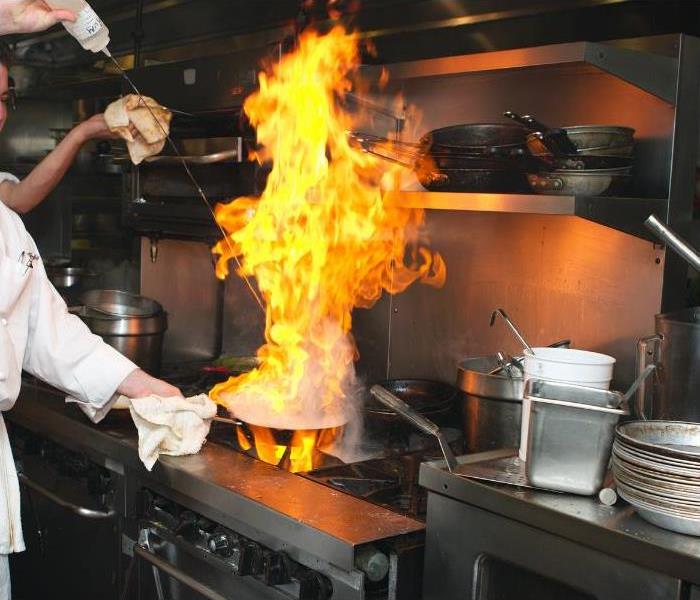 Fire While Cooking in a Commercial Kitchen
Fire While Cooking in a Commercial Kitchen
If you own a restaurant, bar or commercial kitchen in Hamilton Mill or Suwanee, reducing fire risk is critical to continued profitable operation. The National Fire Protection Association (NFPA) reports that fire departments responded to over 7,410 structure fires in the kitchen of restaurants and bars in 2017 alone. The majority of these fires were preventable, resulting in three deaths, 110 injuries, and $165 million in property damage annually in commercial kitchens. These tips will help keep you and your staff safe while preventing shut downs due to fire code violations.
What Are My Ducting and Air Movement Requirements to Prevent Fire?
While Chapter 7 of the NFPA 96 Standard for Ventilation Control and Fire Protection of Commercial Cooking Operations covers this extensively, here are a few key items to keep in mind.
First, commercial kitchen ducts should never pass through firewalls, share an exhaust system with the building ventilation, or have obstructed access panels. While doing these things on a commercial kitchen remodel can save costs in the short term, the fire risk increases significantly. If disregarded, your commercial kitchen work will likely not pass inspection.
Make sure to maintain a minimum clearance of 18 inches between combustible materials and the kitchen ducts. This standard is based on Section 4.2 of the NFPA 96, however is one of the easiest to disregard once the kitchen is operational. Ducts can build up high levels of radiant heat that can ignite combustible materials like boxes, cups, plates, utensils, or other kitchen materials.
If you would like additional information on the types of combustible and non-combustible materials that should and shouldn't be kept near the duct, consult Chapter 3 of the NFPA.
What Are My Commercial Kitchen Fire Extinguisher Requirements?
"The NFPA 96 requires automated fire suppression equipment for all grease removal devices, hood exhaust plenums, and exhaust duct systems in a commercial kitchen, as well as any cooking equipment that produces grease-laden vapors." - Koorsen Fire & Security
The NFPA 96 requires use of class K fire extinguishers in conjunction with automatic fire extinguishing systems. These extinguishers also require installed placards stating their extinguisher class. However, in the case of a commercial kitchen fire, it's critical to activate the automatic fire extinguisher system before using portable-type extinguishers. This is because high-efficiency cooking appliances in many modern commercial kitchens are capable of achieving high temperatures that can raise the vegetable oils to intensely high temperatures. When oil ignites at these high temperatures, it can already be so hot that a portable extinguisher is not enough to stop the flames.
Another standard that you should familiarize yourself with is the UL 300 standard.
According to this article by Insureon, a kitchen’s cooking equipment must meet these UL 300 requirements:
- Fire-extinguishing nozzles in the hood, ducts, and above each cooking appliance
- An automatic fuel shut-off capabilities for both gas and electric power sources
- A manual fuel shut-off pull for all power sources
- A wet-chemical fire-extinguishing system that meets UL 300 criteria (one of which is undergoing semiannual checkups by a certified professional)
If you need immediate assistance after a fire, our teams are available 24/7/365. With our promise of being Faster to Any Size Disaster, you can count on SERVPRO of Buford/Suwanee/Hamilton Mill to be there when it counts. Call us today at (770) 945-5355 for rapid assistance.
Fire Sprinkler Maintenance and Testing
10/27/2021 (Permalink)
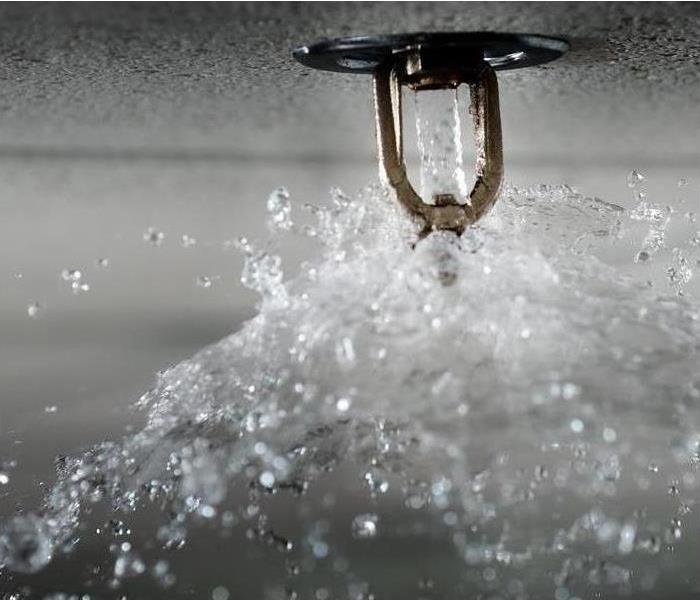 You should test and maintain your fire sprinklers.
You should test and maintain your fire sprinklers.
Don’t wait until a fire has already struck your Buford, GA, property to find out if your sprinklers are working. You should test and maintain your fire sprinklers routinely to ensure that appropriate fire suppression protocols are in place to safeguard your business, your employees, and your inventory.
Fire Sprinkler Maintenance Procedures
Most fire sprinklers have a self-test mode that allows you to simulate what would happen in the event of smoke detection. You should run this test at least once per month (after covering your equipment), but you can also simulate sprinkler function by holding a cigarette lighter near the sprinkler head. To maintain your fire sprinkler, you should:
• Hire a professional for routine inspections. Professionals know building fire codes and standards for sprinklers and can test more accurately than self-testing.
• Conduct your own inspections. Between professional inspections, routinely inspect your fire sprinkler system to see if damage has taken place and all connections are active. Ensure nothing is blocking the sprinklers’ water supply.
• Clean your sprinklers. Fire sprinklers need to be regularly cleaned, particularly the sprinkler heads, so that no blockage prevents them from operating properly.
How to Clean Up After Fire Sprinkler Activation
Once your sprinklers have been activated by smoke or fire, you may have a bit of a sludgy mess on your hands. Wait until a professional has cleared you to enter the building before attempting cleanup. Sprinkler cleanup mostly involves drying and mopping any wet areas, but you may also have to haul out water-damaged equipment and inventory.
Try to avoid leaving standing water, particularly if you have electrical damage after a fire. Standing water can lead to further injuries and mishaps, and it can promote mold growth. Be careful of exposed wires and live power sources around water left behind by your fire sprinkler system.
3 Mold Prevention Facts That Nobody Told You
7/24/2021 (Permalink)
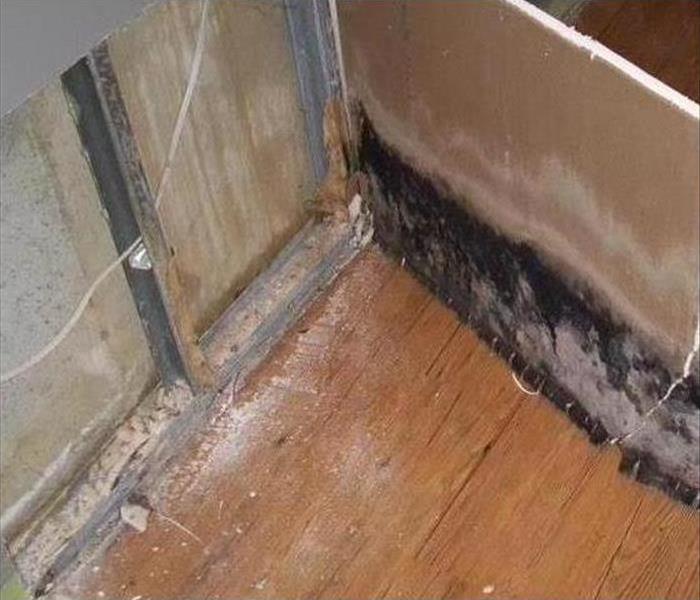 Mold damage in Suwanee, GA.
Mold damage in Suwanee, GA.
Mold Prevention Facts
Tired of trying the same mold prevention methods as everyone else in Suwanee, GA? Here’s why they aren’t working and why you shouldn’t wait too long to deal with water damage.
1. Ventilation Systems Only Work Before Mold Forms
After mold has formed and dried up, its cellular legs become exposed, allowing them to fly through the air like a dandelion seed. Mold can be “planted” once again or remain dormant until it finds a suitable area to grow. Turning on a ventilation system may pull dried mold throughout your building, allowing it to spread. Always stop your ventilation system if you’ve had a mold outbreak.
2. Mold Can Still Spread With Mold-Resistant Materials
When a product like drywall or sheetrock claims to be mold-resistant, it may give you the impression that it completely prevents mold growth. This is simply not true, especially if you’ve already had a mold outbreak and the spores were allowed to spread throughout the building. If the building materials are exposed to moisture for prolonged periods of time, mold can survive on them temporarily until it dries up or finds a better area to settle in the building.
3. The Basement Isn’t Your Only Priority
After water damage, most folks focus their mold prevention efforts only on the inside of a basement, draining it and placing humidifiers throughout. However, before a basement becomes flooded, the water has to come in from the ground around it. If your building isn’t naturally elevated, excess rain water may try to escape directly to the basement.
You may need a professional restoration service to rework the walls in your basement and lay tile lines under the ground around your building. They can guide rainwater away from the basement to help prevent it from entering the building and creating mold.
If you have water damage in Suwanee, GA, don’t wait to deal with it until mold settles in. The key to preventing mold growth is to act quickly and mitigate further damage by restoring the area of your property that has been affected.
5 Steps To Prepare a Commercial Property for Flood Damage
6/24/2021 (Permalink)
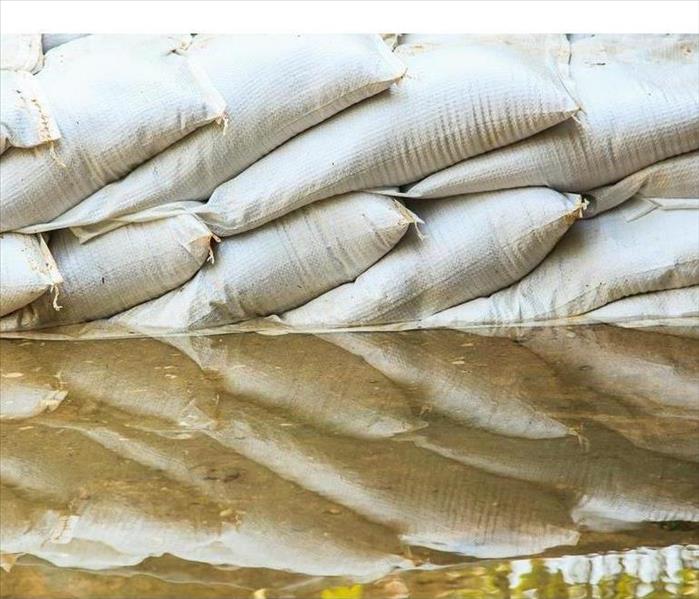 Sandbagging can prevent floodwaters from entering your property.
Sandbagging can prevent floodwaters from entering your property.
Limit The Extent Of Flood And Storm Damage
If your commercial property in Buford, GA is located in a flood zone, you should take measures to prepare your property for flooding risk. These five steps are effective ways for property owners to limit the extent of flood damage and storm damage.
1. Elevate any critical utilities. Raise any electrical panels, switches, or wiring to a higher level. You may want to elevate appliances and heating systems. It is also a good idea to switch off the flow of electricity to any non-necessary appliances.
2. Build sandbag walls to reinforce doors and windows and hold back floodwaters. Sandbagging is a tried-and-true technique for preventing floodwaters from entering your property. Use polyethylene sheeting to build the most effective barriers.
3. Move furniture, important records, and valuables to a dry place. Business owners should come up with a plan that will protect as many building contents as possible. This may limit the extent of clean-up and restoration efforts after flooding.
4. Waterproof the basement and make sure the sump pump is working. If your commercial property has a basement, you should take steps to waterproof the underground portion of the structure well in advance of a flood event. You may also want to install a battery-operated pump or generator to ensure that the sump pump will continue to operate even if the power goes out.
5. Develop a flood evacuation plan. In addition to planning for the safety of your property and contents, you should also develop a flood evacuation plan for occupants. Anyone who ends up stranded in flash flood conditions should avoid flooded areas and moving water.
Following these five steps can help you prepare a commercial property for flooding. If floodwaters enter the structure or damage the contents of the building, contact a restoration company near Buford, GA that specializes in storm damage and flood damage.
What Are Your First Steps After a Commercial Fire?
4/19/2021 (Permalink)
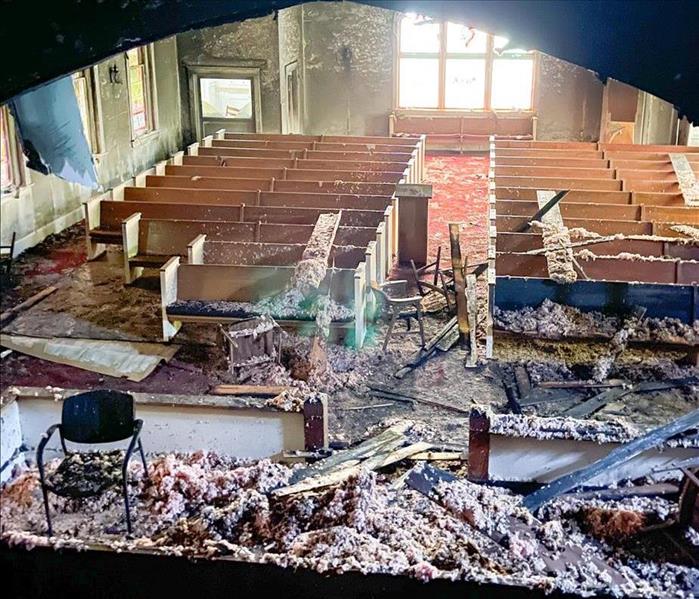 Fire damage in a Sugar Hill, GA building.
Fire damage in a Sugar Hill, GA building.
Fire Restoration Process
If your commercial building in Sugar Hill, GA, has been affected by a fire, the fire restoration process can be overwhelming and confusing. However, if you know the first steps to take after a fire, it can be easier to deal with. After you have called in any professional services you need and made sure that any emergencies are dealt with, you can use these tips on what to do when beginning the fire restoration process.
First Aid
After a fire has impacted your commercial building, the first thing you should always do is check to see if anyone is hurt or needs medical attention. Make sure all building occupants are accounted for and are unharmed. If necessary, get medical attention from emergency services to help treat any injuries.
In the event of a minor burn, you can begin treating it immediately by following these steps:
- Remove any jewelry or clothing
- Cool and moisturize the skin
- Loosely bandage the affected area
- Alleviate lingering pain with over the counter medication
Call Insurance
After calling in a fire and smoke restoration service, you should begin the process of filing a fire claim. Call your insurance company to begin a claim and document damages from the fire as soon as possible. When filing a fire insurance claim, be sure to thoroughly read your coverage and understand how the process will work and keep track of everything needed, including documentation and paperwork. If you're unsure, you can also get a second opinion on the extent of your damage.
Don't Touch the Damage
If your building has been damaged, it's important to stay away and leave it untouched. Trying to fix the damage without professional help can lead to more problems with your commercial building. Instead, call in a professional restoration company to help you with smoke cleaning and other restoration services. However, it's important to document all of the damage for insurance purposes before beginning repairs.
Use these tips to make the fire restoration process as painless as possible and help you get your building up and running again.
Steps To Remove Commercial Mold
2/2/2021 (Permalink)
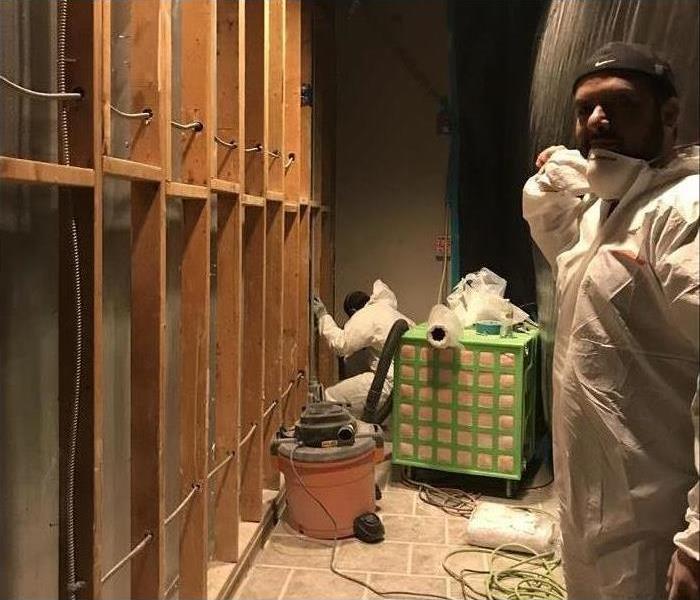 SERVPRO can handle any mold removal
SERVPRO can handle any mold removal
Mold Remediation Steps
Mold loves moist, dark areas in your commercial building. If left unattended, mold growth can cause extensive damage to your facility in Sugar Hill, GA. To eliminate a mold problem, it’s important to understand the typical steps involved in mold remediation.
1. Call an Expert
Don’t try to clean up the mold yourself. Contact a mold remediation expert as soon as possible to lead the effort. The professionals will follow the steps below, as necessary.
2. Assess and Inspect the Facility
Professionals assess the situation by looking for water damage and mold using technological equipment.
3. Contain the Mold
High humidity can trigger further growth quickly, so experts use containment procedures to reduce the risk of spreading mold. Negative air chambers are used to keep affected areas from contaminating other areas. HVAC systems and fans are turned off to discourage mold growth.
4. Utilize Air Filtration Equipment
Air filtration systems help capture and remove mold spores from the air, along with HEPA vacuums and air scrubbers.
5. Remove Moldy Materials and Clean Surfaces
The amount of mold remediation necessary depends on the amount of mold and the texture of the surfaces. Applications using antimicrobial treatments eliminate colonies of mold and reduce the likelihood that they will return. Porous materials containing mold are carefully removed and disposed of properly.
Materials that can be salvaged, such as drywall, furniture and carpeting, are cleaned and sanitized using specialized cleaning techniques. Odors can also be removed from these materials with deodorizing treatments and fogging equipment.
6. Restore the Premises
The level of restoration is dependent on the amount of damage to structures and surfaces. For example, restoration might only include replacing a few sheets of drywall or installing new flooring. If subfloors or other key structures are damaged, major reconstruction may be necessary.
If you are concerned about mold growth in your building, don’t hesitate to call a professional right away.
How a Fire Sprinkler System Works
12/28/2020 (Permalink)
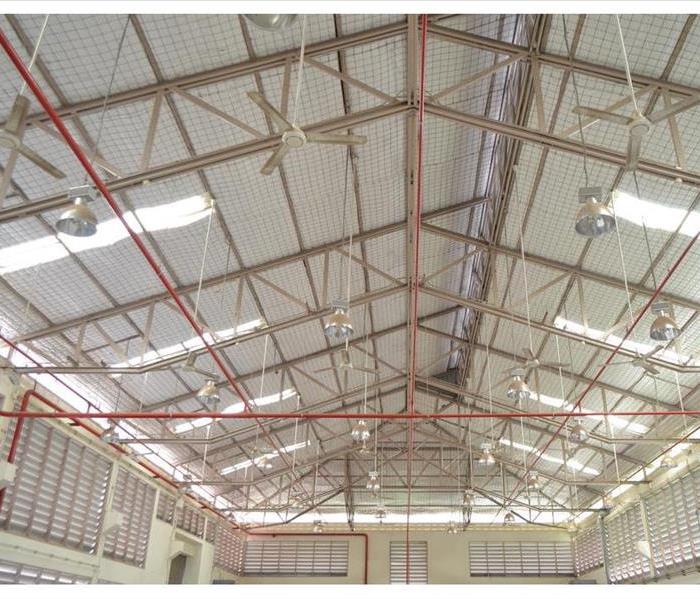 Fire sprinkler system
Fire sprinkler system
If you have a fire sprinkler system at your business property in Buford, GA, you have hopefully never seen the system in action. However, it's a good idea to know how it functions.
Parts of a Sprinkler System
The typical sprinkler consists of:
- Pipes containing water under pressure
- Plug that holds back the water
- Glycerin-filled glass bulb holding the plug in place
- Deflector that sprays water around the fire area
A network of pipes runs between the individual sprinkler heads. The water is always in the piping, meaning the system is ready to initiate fire suppression when activated.
Conditions for Activation
If a fire starts, the air temperature above it will rise. When it reaches about 160 degrees Fahrenheit, the glycerin will expand and break the bulb, springing open the plug. Water leaves the pipe, and the deflector sprays it around the room. Because the glycerin responds only to temperature, smoke alone will not activate the fire sprinkler system. If the fire spreads, the hot air will activate other sprinklers, but only the ones triggered by the rise in temperature will go off.
Advantages of a Sprinkler System
What makes a sprinkler system so effective is that it works quickly. Before the fire department can arrive, the system has begun fire suppression. In many cases, the system will contain and possibly extinguish the fire. Your property may experience less damage than it would without the system. Fire sprinkler cleanup and professional restoration may also be easier. The fire may be better contained and extinguished with less water than a fire that had the chance to spread before firefighters arrive.
Common Sprinkler System Myths
In the movies, it seems that a small trigger sets off a room full of sprinklers. However, that's not the way a system works. It's activated by high heat, so candles and toasters will not set it off, and only the sprinklers above the heat will activate.
If you haven't installed a fire sprinkler system in your business, it's worth considering. In the event of a fire, a sprinkler system can give your business added protection.
How To Handle a Major Water Problem
12/15/2020 (Permalink)
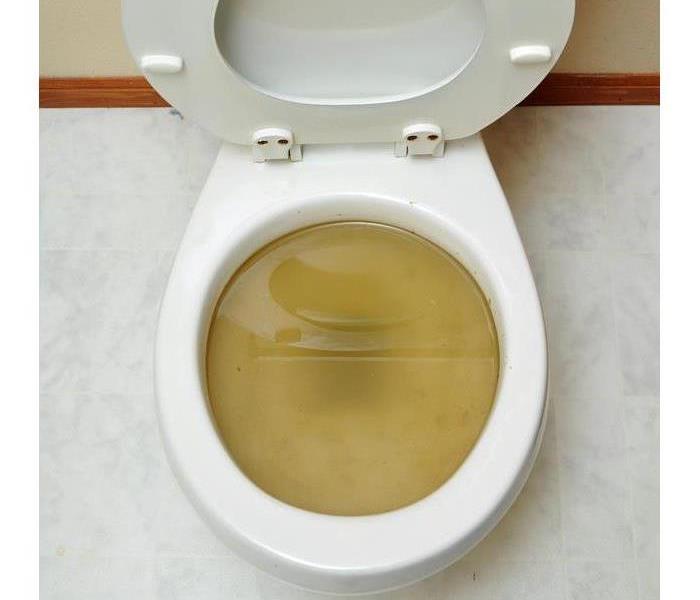 One common instance of sewer damage is when a full toilet overflows
One common instance of sewer damage is when a full toilet overflows
When it comes to water damage in your commercial building in Buford, GA, each situation is unique. Some problems are straightforward, while others require the expertise of a professional water remediation franchise. Any situation that involves sewer damage is more complicated. That's because contaminated water not only poses a threat to humans but also can cause more damage to ceilings, flooring, walls and insulation.
As in all cases of damage from water, the source of the problem should be stopped right away. This is followed by an inspection and assessment of the impacted area by certified technicians. They will then develop an appropriate restoration plan.
Dealing With Toilet Overflow
One common instance of sewer damage is when a full toilet overflows. If the toilet is on a second floor or higher, the water can penetrate the flooring and then leak down into the floor below. When this happens, professional technicians can take the following actions:
- Arrive on site fast and wearing PPE
- Stop the source of the contamination
- Restore all flooring and ceiling materials
- Disinfect and sanitize the area
You should consult your insurance agent as soon as you can. The agent can advise you on what portions of the damages and expenses are covered. Having a professional sewage company deal with a flooded toilet is likely to produce the best results.
Handling Other Sewage Damage Scenarios
Raw sewage coming into your place of business is a serious situation. It can happen in a number of ways. A sewage backup can occur when an outgoing line becomes clogged with obstructions such as a rock or tree roots. Another possibility is when a sewage line pipe breaks due to old age or some sort of trauma. A third possibility is a flood that brings in contaminated water from the outside of your building.
Whatever the cause of the problem, sewer damage situations are best handled by professionals with the training and equipment to deal with complicated restorations.
3 Reasons You Need Business Insurance
11/11/2020 (Permalink)
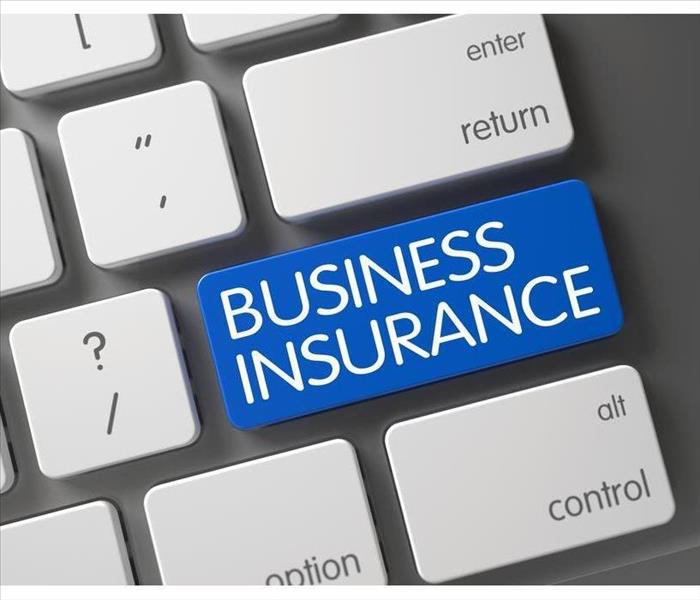 Paying for insurance regularly might not sound appealing, but it is better than the alternative
Paying for insurance regularly might not sound appealing, but it is better than the alternative
The Following Are A Few Reasons Why
If you own a business in Buford, GA, then there are steps that you should take to protect that business. One of these is purchasing insurance that covers water damage and other emergencies. It might seem like this is just an extra expense that you could do without, but this is not the case.
1. Repairs Can Be Expensive
Paying for insurance regularly might not sound appealing, but it is better than the alternative. If you are dealing with broken pipes or something else that causes flooding in the building, the cost of repairs can be high. Not only can it affect the building, but it can also cause damage to the items within it. Without insurance, you will be stuck paying for repairs and replacements on your own, which will cost your business a lot of money.
2. Water Damage Is a Common Occurrence
Many people like to think that, while bad things happen to other people, a disaster probably won’t happen to them. Unfortunately, water causes damage often, and chances are it will affect your building at some point. Whether it comes from a storm, leak or broken appliance, insurance can be a lifesaver in this situation.
3. You Could Lose Profits During Restoration
If the damage is severe, then water cleanup and repairs can take a while. Sometimes, building materials such as drywall or insulation need to be torn out and replaced. Mold growth can occur as well. If you are unable to operate your business as usual during this time, insurance can help minimize loss.
Restoration should be done as soon as possible to reduce secondary damage. Hiring a water damage remediation company is your best bet for getting your business ready to go again quickly, and insurance helps ensure you can cover those costs as you get up and running.
Commercial Pipe Burst Cleanup
8/24/2020 (Permalink)
A pipe burst cleanup can look overwhelming at first glance. If you have ever undergone a water cleanup before, then you know that this can be a stressful time. As a business owner, you may find that you are less overwhelmed if you understand the process behind the cleanup.
What Happens During a Pipe Burst Cleanup
- Safety First
You and the restoration company cannot begin pipe burst cleanup procedures until you take the proper safety precautions. Make sure the water is off so that no more can enter the building. Additionally, it may be a wise move to shut down the power. If there are any electrical outlets or appliances that have been soaked, you have to keep an electrical current out of there.
- Item Removal
Once you’ve taken care of safety, you can focus on what you can and cannot remove. Take everything that is salvageable outside to dry. You can clean all of your items outside of the building. Keep in mind that contents made out of porous materials can trap mold and mildew and should be thrown away.
- Water Extraction
The water extraction could go a number of different ways. If it isn’t too bad, then you can always mop up the water or use towels to soak it up. In some cases, the water cleanup may require you to use a more advanced strategy. If this is the case, you can use a pump to drain water.
- Drying and Dehumidifying
After you deal with a supply line leaking, you have to focus on drying out your business the best that you can. You can do this with fans and open windows. However, you can also purchase a dehumidifier. This will get rid of all excess moisture in the building.
A pipe burst cleanup can be difficult to undergo. However, it does not have to be stressful, and with professional assistance you can take care of a flood in Buford, GA quickly and easily.
What To Look For In a Mitigation and Restoration Service
4/21/2020 (Permalink)
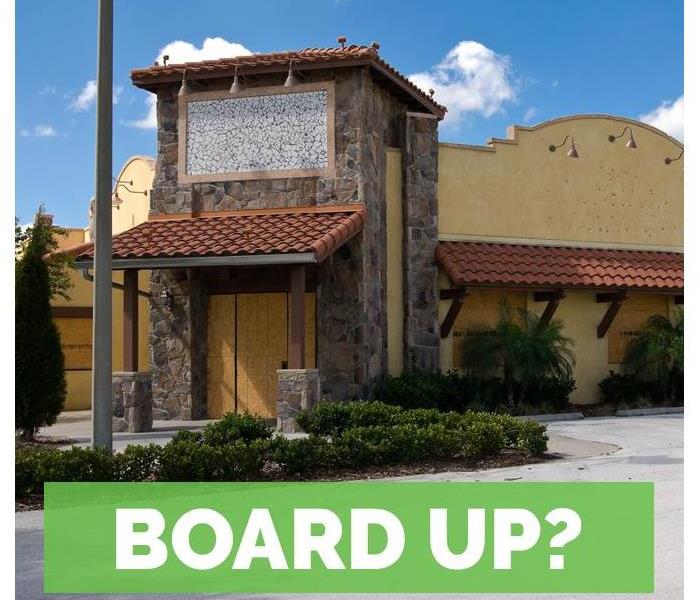 SERVPRO of Buford / Suwanee / Hamilton Mill offers board up services
SERVPRO of Buford / Suwanee / Hamilton Mill offers board up services
Select a Firm That Meets All of These High Standards
A single service can mitigate and restore commercial property damage in Buford, GA. If you decide to rely on the same company for fire damage recovery from start to finish, select a firm that meets all of these high standards.
Short Response Times
Commercial property owners should rely on a service that responds to reports of damage 24 hours a day, seven days a week. Look for a mitigation and restoration company that offers the following services:
- Immediate response
- Nearby restoration franchise locations
- Boarding up and roof tarping
- IICRC-approved cleanup methods
A local or regional franchise can be a better choice than an independent mitigation and restoration service provider. Larger companies guarantee trained staff and the availability of equipment for mitigation and cleanup.
Detailed Estimates
A company that performs mitigation and restoration is prepared to provide a detailed estimate of the total cost of services. Fire mitigation costs may include boarding-up or tarping followed by the cleanup and restoration of water, fire and smoke damage. An insurance adjuster should be able to access estimates, documentation of damage and an itemized list of losses.
Water and Fire Damage Cleanup
Damage cleanup should commence as soon as possible. A commercial structure that has sustained water damage from fire suppression may need to be pumped out and the affected area will need to dry prior to cleaning.
Complete Restoration
A service that handles every stage of damage recovery from water and fire cleanup to restoring smoke damage can provide an accurate estimate at the start of the process. Relying on a single service makes it easier to stay on schedule and ensure that all mitigation, cleanup, and restoration measures are held to the same high standard.
A one-stop shop is the best choice for restoring fire damage at a commercial property in Buford, GA. Simplify the claim-making process by contacting a preferred provider of mitigation and restoration services.





 24/7 Emergency Service
24/7 Emergency Service














